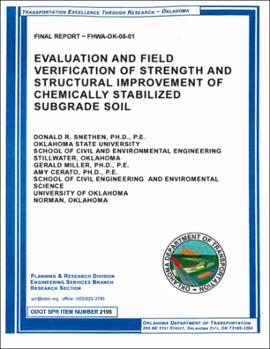| dc.creator | Snethen, Donald R. | |
| dc.creator | Miller, Gerald | |
| dc.creator | Cerato, Amy | |
| dc.date.accessioned | 2018-04-20T22:47:14Z | |
| dc.date.available | 2018-04-20T22:47:14Z | |
| dc.date.issued | 20018-7 | |
| dc.identifier.govdoc | FHWA-OK-08-01 | |
| dc.identifier.other | Oklahoma Department of Transportation State Planning and Research item number 2195 | |
| dc.identifier.uri | https://hdl.handle.net/11244/299474 | |
| dc.description.abstract | Often subgrade soils exhibit properties, particularly strength and/or volume change properties that limit their performance as a support element for pavements. Typical problems include shrink-swell, settlement, collapse, erosion or simply insufficient strength. A common approach to subgrade soil support or stability problems involves chemical modification or stabilization with additives such as lime (hydrated or quick), fly ash (Class C from lignite coal), cement kiln dust (CKD) or Portland cement. Other additives are available, but this group constitutes the major products or by-products used on roadway construction in Oklahoma. The type and amount of chemical additive is dependent on the purpose or function of the treated material (i.e., improved physical properties or improved strength) and selection is based on accepted or standardized procedures. Questions then arise with regard to chemically treated subgrade soils about the rate of development and ultimate value of improvement. The purpose of this research is to develop relationships between rate of development and magnitude of strength (or physical property) improvement for chemically treated subgrade soils. The research project involved laboratory and field studies of the influence of cementitious additives on the strength and structural improvement of stabilized subgrade soils. Laboratory tests for measuring strength and structural improvement (e.g. UCS and MR) were conducted on field mixed treated soils and laboratory mixed treated and untreated soil samples. UCS and MR tests were conducted on samples varying curing time (field and laboratory mixed) and percent additive used (laboratory mixed). A series of field tests (Nuclear w-?, stiffness gauge, portable FWD, Dynamic Cone Pentrometer, and PANDA Pentrometer) were conducted at five field test sites on the untreated subgrade soils and on the treated subgrade soil with curing time as allowed by the construction schedule. The research project collected a large volume of both laboratory and field data which are summarized in the appendixes (5) to this report. | |
| dc.format.extent | 246 pages | |
| dc.format.extent | 1,004,492 bytes | |
| dc.format.medium | application.pdf | |
| dc.language | en_US | |
| dc.relation.ispartofseries | No | |
| dc.relation.requires | Adobe Acrobat Reader | |
| dc.title | EVALUATION AND FIELD VERIFICATION OF STRENGTH AND STRUCTURAL IMPROVEMENT OF CHEMICALLY STABILIZED SUBGRADE SOIL (FHWA-OK-08-01 2195) | |
| dc.type | Technical Report | |
| dc.description.version | Final Report October 2006-September 2008 | |
| dc.description.peerreview | No | |
| dc.type.material | text | |
| dc.subject.keywords | Soils | |
| dc.subject.keywords | soil modification | |
| dc.subject.keywords | soil stabilization | |
| dc.subject.keywords | checmical treatment | |
| dc.subject.keywords | chemical additives | |
| dc.subject.keywords | subgrade strength | |
| dc.contributor.sponsor | Oklahoma Department of Transportation. Materials and Research Division. Office of Research & Implementation | |
